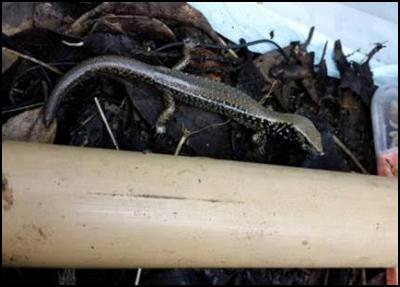Whitaker’s Skink recovers at Wellington Zoo
Nationally Vulnerable Whitaker’s Skink recovers at Wellington Zoo

A Nationally
Vulnerable Whitaker’s Skink has returned to a breeding
programme after veterinary treatment at Wellington
Zoo.
The female skink, nicknamed Chitwah by Zoo staff, is part of a recovery plan for the species and arrived at The Nest Te Kōhanga in April in an emaciated state and with an injured tail.
Skinks are the most frequently encountered reptiles in New Zealand, but predation and habitat loss are a big threat to their survival.
“Skinks play an important role in our gardens as they are insectivores who love eating pest invertebrates like moths, small slugs and other insects that live in the leaf litter and mulch,” said Amanda Tiffin, Practice Manager at The Nest Te Kōhanga. “Skinks can also help to disperse seeds from native plants, as they sometimes supplement their diet with fruit and berries.”
After being treated at The Nest Te Kōhanga for the past five months, the skink’s tail has started to grow back and she has reached a healthy weight.
“Our Vet Team made the decision to house the skink over winter so she could continue to gain weight, avoid brumation which is a reptile’s version of hibernation, and therefore have the best chance at survival,” said Amanda. “Leading up to Chitwah’s release, we started to acclimatise the skink to the outside temperature so that she could transition back to her habitat without any issues.”
Chitwah’s carer, Dennis Keall works with the Department of Conservation to breed endangered native reptiles and has one of the most successful breeding programmes for native skinks and geckos in human care in New Zealand.
Whitaker’s Skinks are rare in New Zealand as they are only found on Mercury Island, Castle Islands and locally in Pukerua Bay.
“The community can help protect our native reptiles by creating lizard-friendly habitats in their gardens through planting native trees and shrubs, as well as providing shelter from small introduced predators like cats by keeping the pet cat indoors at night,” said Amanda. “By keeping cats in at night and planting native plants in our gardens you can help protect the Whitaker’s Skink as well as other native lizards and geckos that share their habitat.”
“Working with people like Dennis Keall to help save native wildlife is a crucial part of the work we do at The Nest Te Kōhanga. Combining our efforts and expertise is crucial to conserve these unique reptiles.”
About The Nest Te Kōhanga
The Nest Te Kōhanga is Wellington Zoo’s animal hospital and centre for native wildlife veterinary care.
ends


 Gordon Campbell: On The Clash Between Auckland Airport And Air New Zealand
Gordon Campbell: On The Clash Between Auckland Airport And Air New Zealand NZ Government: Reducing Ambiguity About What Is Reasonably Practicable For Health And Safety Compliance
NZ Government: Reducing Ambiguity About What Is Reasonably Practicable For Health And Safety Compliance Office of the Speaker: New Zealand Parliamentarians Attend 150th IPU Assembly
Office of the Speaker: New Zealand Parliamentarians Attend 150th IPU Assembly RNZRSA: RNZRSA Supports Willie Apiata VC's Stand To Drive Change To Veterans’ Support Act
RNZRSA: RNZRSA Supports Willie Apiata VC's Stand To Drive Change To Veterans’ Support Act Diane McCarthy - LDR: War Hero Willie Apiata Entrusts MP With Victoria Cross Medal
Diane McCarthy - LDR: War Hero Willie Apiata Entrusts MP With Victoria Cross Medal PSA: Disappointing Govt Attack On Diversity, Inclusion In Public Service
PSA: Disappointing Govt Attack On Diversity, Inclusion In Public Service NZ Labour Party: Govt Health And Safety Changes Put Workers At Risk
NZ Labour Party: Govt Health And Safety Changes Put Workers At Risk


